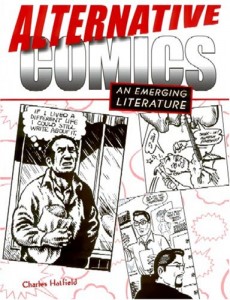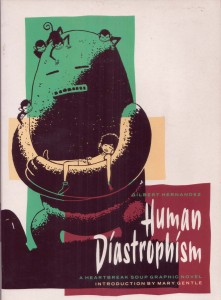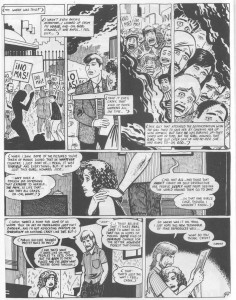I enjoyed rereading Charles Hatfield’s Alternative Comics: An Emerging Literature. I’m not the argumentative type, I don’t have any real objections to the book. I primarily feel a certain sense of distance from many of its chapters.
The first chapter offers a historical overview of the “Rise of Alternative Comics.” I’m not a history buff, or even a comics history buff, so I have no idea how Charles’ (I’m going to call him Charles since we’ve met a few times) history compares with others on the subject, if there even are others on the topic. The first time I read it, it was quite the eye-opener, getting that background understanding of the underground comics, the direct market, and alternative comics. By the time I started reading comics, the direct market was well settled into its boom years as was the glut of self-published (or small publisher published) black and white alternative comics. Having never warmed to any of the underground “comix” (I still recall the sign above the front of my local comic store, which read “COMIX” in the stark lines of electrical tape), this mapping of the historical context provided some much needed perspective for me.
The latter chapters of the book focus on a number of comics artists and works which, I have to say, I have no real affection for (Gilbert Hernandez, Pekar, Crumb), have never read (Green), or haven’t read in a decade or more (Spiegelman/Maus). I’ve always found it hard to really engage with criticism that doesn’t use texts which I have read or appreciate, the insights seem less incisive, less powerful, the readings less able to expand through one’s own context/memory of the original. It’s rare that I get past that point (Genette’s Narrative Discourse, which primarily deals with Proust, a writer I do not enjoy, being a notable example where I have gotten past this issue).
So it is to Charles’ credit that I have read those chapters twice now. I have long been the reader who bought and read Love & Rockets exclusively for Jaime’s material (those days when the brothers had separate books were my favorite), I find Gilbert’s work not to my taste on a number of levels. Charles’ writing was one of the pieces of criticism that finally did get me to go back and read all of Gilbert’s work from volume 1 of L&R (the Palomar book and the Poison River book). (The others being Douglas Wolk’s reading of Love & Rockets X in his Reading Comics (that book being the one Gilbert Hernandez volume I do own and have read a few times), and a piece by sometimes commenter David Turgeon that I translated for du9 about ellipses in Poison River.) And while comments on earlier posts in this roundtable have focused on the political over the formal in Hernandez’s work, it was the formalistic reading that Charles brought to the examples that drew me in.
Continue reading →





